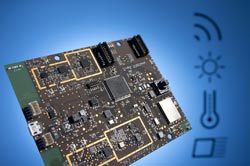Plethora – the universal prototyping platform for wireless systems

Plethora combines a wide selection of sensors and wireless modules and interfaces. So developers are able to implement and test different data transmission systems on a single platform.<br>Bernd Müller / Fraunhofer ESK<br>
Plethora was originally designed to make it easier to test different distributed data collection and localization processes with a single hardware platform.
However, because Plethora provides all developers of complex, distributed applications in fields such as building or process automation greater testing leeway, Fraunhofer ESK researchers are introducing the prototyping platform to the public for the first time at the embedded world trade fair in Nürnberg (February 25-27, 2014, stand 5-250, hall 5).
For applications that require distributed data collection and processing capability, developers are likely to have various solutions at their disposal, all of which need different sensors and wireless technologies. The issue is that it is often not possible to test different system designs because different platforms would be required. Plethora addresses this problem by offering a single platform for the prototype implementation and testing of different data transmission, automation or localization processes.
To achieve this, the system combines a wide selection of sensors and various modules and interfaces. Using Plethora, developers can test solutions for diverse application scenarios in a near-real environment and among other tasks, compare the various properties of different wireless technologies in an easy and efficient manner. With its modular design, the platform furthermore offers an ideal basis for installing additional complex sensors or wireless modules.
Technical data
The sensors and wireless modules are controlled by a high-performance Cortex-M3 microcontroller. The platform comes installed with the following sensors: barometer, accelerometer, magnetometer, temperature, humidity and ambient light. Additional external sensors can be connected. For communication and localization, Plethora features a transceiver in the 868 MHz band, as well as IEEE 802.15.4 and IEEE 802.11 b/g compliant transceivers for the 2.4 GHz band.
Each receiver has its own amplifier and software-controlled antenna outputs that can also be used to analyze the impact of various antennas and transmission levels on the localization and range of the system. Plethora can be powered by a lithium-polymer battery, as well as by a USB or 12V connection, both of which can be used to charge the battery.
For developers who need additional functionality, other modules are very easy to connect by means of a CAN bus or via SPI, I2C and UART interfaces, which are accessible through 12-pin expansion connectors.
Outlook
The next phase of development involves integration of an ultra wideband transceiver, which enables significantly higher speeds for video transmissions and precise localization algorithms. In parallel, the comprehensive software framework will be enhanced in order to further simplify access to the system and to better link the various technologies with one another.
Plethora's flexibility puts Fraunhofer ESK in the position of being able to develop localization and communication systems tailored to the individual needs of the customer. Interested customers can even employ the system to implement their own ideas. Examples of the situation-specific requirements and concepts that make custom development necessary include the type of power supply, the integration of existing sensors and networks and the special characteristics of the application itself.
Media Contact
More Information:
http://www.esk.fraunhofer.de/en/media/press_releases/pm1401.htmlAll latest news from the category: Trade Fair News
Newest articles

First-of-its-kind study uses remote sensing to monitor plastic debris in rivers and lakes
Remote sensing creates a cost-effective solution to monitoring plastic pollution. A first-of-its-kind study from researchers at the University of Minnesota Twin Cities shows how remote sensing can help monitor and…

Laser-based artificial neuron mimics nerve cell functions at lightning speed
With a processing speed a billion times faster than nature, chip-based laser neuron could help advance AI tasks such as pattern recognition and sequence prediction. Researchers have developed a laser-based…

Optimising the processing of plastic waste
Just one look in the yellow bin reveals a colourful jumble of different types of plastic. However, the purer and more uniform plastic waste is, the easier it is to…



